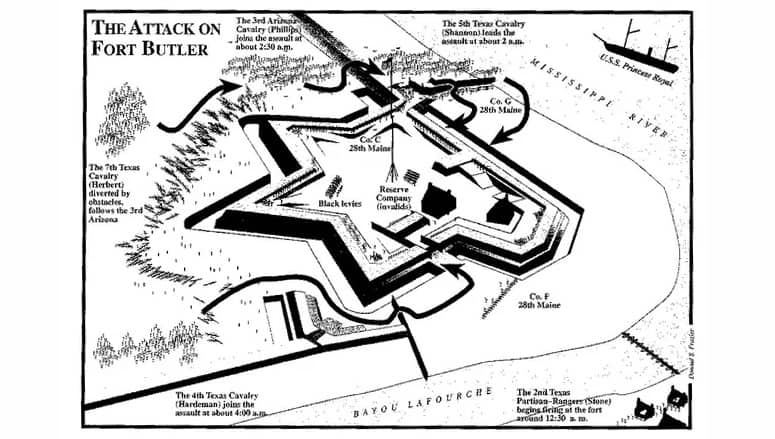June 21, 1863 – July 4, 1863
By Phil Kohn
Phil Kohn can be reached at USCW160@yahoo.com
On June 22, 1863, Maj. Gen. Richard Taylor’s Confederates capture the Union garrison at Brashear City, Louisiana, then attack the Federal-held Fort Butler, at Donaldsonville, Louisiana. Unable to take the fort, the Confederates place artillery on the banks of the Mississippi River and halt Federal river traffic. Confederate patrols get within 20 miles of New Orleans, the closest they come to the captured city since the spring of 1862. In the waters off New England, the Confederate cruiser CSS Tacony, commanded by Lt. Charles Read, captures five U.S.-flagged vessels on this day alone, despite being hunted by the U.S. Navy. As the first elements of the Confederate Army begin to approach Chambersburg, Pennsylvania, businesses and shops in Philadelphia begin closing.
On June 23, Maj. Gen. Joseph Hooker, still unaware of Lee’s whereabouts or destination, prepares to move the Federal Army of the Potomac across the river of the same name from Virginia into Maryland, heading northward towards Frederick. U.S. Maj. Gen. Grant’s forces step up the pressure on besieged Vicksburg by increasing the frequency of shelling.
Gen. Robert E. Lee’s Confederate troops under Lt. Gens. James Longstreet and A.P. Hill reach Chambersburg, Pennsylvania, on June 24. Maj. Gen. Hooker wires Washington that he intends to send a corps or two across the Potomac to secure the capital (against the previous directive of Maj. Gen. Henry Halleck, commander of the U.S. Army) then move on Lee’s line of march. However, he asks for orders, since, he says, “I don’t know whether I am standing on my head or feet.” In Mississippi, Vicksburg, besieged by 77,000 Federal troops under Maj. Gen. Grant, is bombarded by artillery 24 hours a day. Some residents have moved into caves for protection, and food is scarce. Despite pleas from Richmond for action, Gen. Joseph Johnston, with 31,000 Confederate soldiers north, northeast and east of Grant’s lines, feels his force is too small to attack, and does little to relieve Vicksburg.
On June 25, in middle Tennessee, Maj. Gen. William Rosecrans moves his 56,000 Federal soldiers against the 44,000 troops of Gen. Braxton Bragg, in part to prevent the Confederates from moving toward Mississippi, bringing reinforcements to Vicksburg. Bragg’s continuing bad relations with his subordinate generals cripples the Southern response and Rosecrans’s Union force defeats Bragg’s troops at Liberty Gap, forcing their retreat southward toward Tullahoma, Tennessee. The Federals occupy Manchester, Tennessee, on June 27 and Shelbyville, Tennessee, on June 28. In Virginia, having received permission from Gen. Lee to do so, Maj. Gen. “Jeb” Stuart leads his cavalry on a ride between the Army of the Potomac and Washington, D.C. Stuart plans to rendezvous with Lee’s Army north of the Potomac afterward. This route — still controversial — will keep the Confederate cavalry away from Lee’s main body for several days.
Confederates under Maj. Gen. Jubal Early arrive at Gettysburg, Pennsylvania, on June 26 where they skirmish with some Union troops outside of town. Maj. Gen. Joseph Hooker— late in getting his Army of the Potomac moving — wires President Lincoln that he intends to move against Robert E. Lee’s Army of Northern Virginia. Lincoln, however, is having doubts about Hooker’s abilities. In the harbor of Portland, Maine, the Confederate schooner CSS Archer, commanded by Lt. Charles Read (he had transferred his command from CSS Tacony), in a night raid seizes the Federal revenue cutter USRC Caleb Cushing. However, attacked by two steamers and three tugboats, the Confederates are unable to get away, and surrender. Lt. Read is taken prisoner. The U.S. Navy had deployed some 47 ships looking for Read and his crew, who had captured 21 vessels in 19 days.
On June 27, part of the Confederate Army is marching on Harrisburg, Pennsylvania’s capital. The main body of Lee’ force arrives at Chambersburg. In Washington, President Lincoln, after a discussion with army chief Maj. Gen. Henry Halleck (with whom Maj. Gen. Hooker has been arguing over strategy), decides to remove Joseph Hooker from command of the Army of the Potomac, replacing him with corps commander Maj. Gen. George Meade.
June 28 is a day of much Confederate activity. The forces of Lt. Gens. James Longstreet and A. P. Hill skirmish with Federal militia near Chambersburg, Pennsylvania. Lt. Gen. Richard Ewell’s troops occupy Carlisle and then take position on the banks of the Susquehanna River, across from Harrisburg, Pennsylvania. Confederates under Maj. Gen. Jubal Early occupy York, Pennsylvania. Meanwhile, Maj. Gen. “Jeb” Stuart’s Confederate cavalry has crossed the Potomac River at Rockville, Maryland, just west of Washington, D.C. Gen. Lee, learning that the Federal Army of the Potomac is now north of the Potomac River, changes his strategy: Instead of continuing the move on Harrisburg, Lee orders his forces to converge on Gettysburg to head off the Union army.
There is a fierce cavalry skirmish on June 29 at Westminster, Maryland, between some of Stuart’s almost 6,000 horsemen and 100 Union troopers of the 1st Delaware Cavalry, under Maj. Napoleon Knight. Because of their stronger numbers, the Confederates beat back the Federals easily. But because of the delay caused by the fighting, Stuart decides to remain in Westminster overnight instead of pushing on to Gettysburg, roughly 24 miles to the northwest. Maj. Gen. Meade moves his roughly 100,000-strong Army of the Potomac towards Gettysburg, Pennsylvania, where Maj. Gen. John Buford’s Union cavalry is already positioned. In Tennessee, Maj. Gen. Rosecrans’s troops continue to harass Gen. Braxton Bragg’s Confederates as they move southward.
On June 30, Federal cavalry led by Brig. Gen. Judson Kilpatrick attacks Maj. Gen. “Jeb” Stuart’s Confederate mounted troops at Hanover, Pennsylvania, about 15 miles east of Gettysburg. In the fighting, Stuart is almost captured; more importantly, the fighting delays him by yet another day from joining Lee. Maj. Gen. Meade dispatches infantry under Maj. Gen. John Reynolds to occupy Gettysburg ahead of his main force and to join with Buford’s cavalry. In Tennessee, Bragg, pushed by Rosecrans, orders a retreat from Tullahoma southeastward across the Tennessee River. In Washington, D.C., President Lincoln feels pressure from several quarters to bring back Maj. Gen. George McClellan to lead the Army of the Potomac. Lincoln staunchly refuses to do so.
On July 1, in Pennsylvania, the Battle of Gettysburg begins when two Confederate divisions tangle with advance units of the U.S. Army of the Potomac. Fighting ratchets up quickly, and Maj. Gen. John Reynolds, commander of the U.S. I Corps, is killed within the first hour. As reinforcements for both sides pour in throughout the day, the battle rages. The Confederates push the Federals through town, wrecking the Union I Corps and routing the Union XI Corps. By day’s end, both armies are positioned south of town about a mile apart: the Federals on Cemetery Ridge, the Confederates on Seminary Ridge to the west. In Kentucky, Brig. Gen. John Hunt Morgan leads 2,500 Confederate horsemen across the Cumberland River, heading north on a raid, eluding the forces of Maj. Gen. Ambrose Burnside. U.S. Brig. Gen. James Blunt reinforces the garrison occupying Fort Gibson in the Cherokee Nation of Indian Territory.
At Gettysburg on July 2, there is fierce fighting on both ends of the Union lines along Cemetery Ridge— at Culp’s Hill on the north, and at the Peach Orchard and Little Round Top on the south. The Confederates cannot break the Union lines. In Tennessee, the Federal forces led by Maj. Gen. William Rosecrans are at Tullahoma, while Gen Braxton Bragg’s Confederates are withdrawing southeastward towards Chattanooga. At Vicksburg, Mississippi, the situation is little changed: the besieged Confederates in the city, under increasingly poor conditions, continue to fend off harassing Union forces.
On July 3 at Gettysburg, after a thunderous, two-hour artillery duel between the two armies, Gen. Lee orders three Confederate divisions (about 15,000 men) — over Lt. Gen. James Longstreet’s strenuous objections — to march across open fields to attack the center of the Union line on Cemetery Ridge. Only half return. The failure of “Pickett’s Charge,” as the advance is often called, decides the outcome of the battle. The three-day casualty totals are shocking — for the Union: 23,049 of some 88,000 engaged; for the Confederacy: 28,063 of about 75,000 involved. Columbia, Kentucky, sees skirmishing between Union troops and Brig. Gen. John Hunt Morgan’s cavalry.
Under an agreement reached the day before in a meeting with Maj. Gen. Ulysses Grant, Gen. John Pemberton on July 4 — after a month-long siege with no hope of relief and almost no food remaining in the city — formally surrenders 29,000 Confederate defenders and the city of Vicksburg, Mississippi. On the same day, Lee’s Army of Northern Virginia, in heavy rain, begins retreating from Gettysburg towards Virginia. Despite urgings from Washington, Maj. Gen. George Meade does not move the exhausted Union army after the retreating Confederates. In Arkansas, some 7,000 Confederates attack Helena, on the eastern edge of the state, which is defended by around 4,100 Federal troops. Not only does the assault fail, but the Confederates are soundly defeated and withdraw in considerable disarray.








